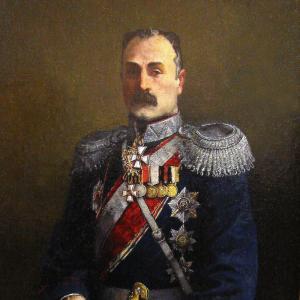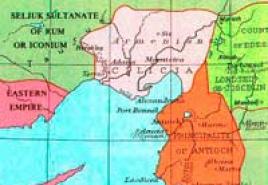Examples of induction. Method of mathematical induction: solution examples
Deduction This is a way of reasoning from general provisions to particular conclusions.
Deductive reasoning only concretizes our knowledge. A deductive conclusion contains only the information that is in the accepted premises. Deduction allows you to obtain new truths from existing knowledge using pure reasoning.
Deduction gives a one hundred percent guarantee of the correct conclusion (with reliable premises). Deduction from truth produces truth.
Example 1.
All metals are ductile(b O least valid premise or main argument).
Bismuth is a metal(reliable premise).
Therefore, bismuth is plastic(correct conclusion).
Deductive reasoning that produces a true conclusion is called a syllogism.
Example 2.
All politicians who allow contradictions are a joke(b O the largest reliable premise).
E Ltsin B.N. admitted contradictions(reliable premise).
Therefore, E.B.N. is a joke(correct conclusion) .
Deduction from a lie comes a lie.
Example.
Help from the International Monetary Fund always leads to prosperity for everyone(false premise).
The IMF has been helping Russia for a long time(reliable premise).
Therefore, Russia is prospering(false conclusion).
Induction – a way of reasoning from particular provisions to general conclusions.
The inductive conclusion may contain information that is not present in the received premises. The validity of the premises does not mean the validity of the inductive conclusion. Premises make the conclusion more or less likely.
Induction does not provide reliable, but probabilistic knowledge that needs to be verified.
Example 1.
G.M.S. - pea jester, E.B.N. - pea jester, Ch.A.B. - pea jester(reliable premises).
G.M.S., E.B.N., Ch.A.B. – politicians(reliable premises).
Therefore, all politicians are clowns(probabilistic conclusion).
The generalization is plausible. However, there are politicians who can think.
Example 2.
In recent years, military exercises have been conducted in region 1, region 2 and region 3 - the combat capability of units has increased(reliable premises).
In area 1, in area 2 and in area 3 units of the Russian Army took part in the exercises(reliable premises).
Consequently, in recent years, combat capability has increased in all units of the Russian Army.(inductive invalid inference).
A general conclusion does not logically follow from particular provisions. Showy events do not prove that there is prosperity everywhere:
In fact, the overall combat capability of the Russian Army is catastrophically declining.
A variant of induction is inference by analogy (based on the similarity of two objects in one parameter, a conclusion is drawn about their similarity in other parameters as well).
Example. The planets Mars and Earth are similar in many ways. There is life on Earth. Since Mars is similar to Earth, Mars also has life.
This conclusion is, of course, only probabilistic.
Any inductive conclusion needs to be verified.Dmitry Mezentsev (coordinator of the project "Russian Society of Good Action") 2011
Induction and deduction are interrelated, complementary methods of inference. A whole occurs in which a new statement is born from judgments based on several conclusions. The purpose of these methods is to derive new truth from pre-existing ones. Let's find out what it is and give examples of deduction and induction. The article will answer these questions in detail.
Deduction
Translated from Latin (deductio) it means “deduction”. Deduction is the logical conclusion of the particular from the general. This line of reasoning always leads to a true conclusion. The method is used in cases where it is necessary to derive the necessary conclusion about a phenomenon from a generally known truth. For example, metals are heat-conducting substances, gold is a metal, we conclude: gold is a heat-conducting element.
Descartes is considered the founder of this idea. He argued that the starting point of deduction begins with intellectual intuition. His method includes the following:
- Recognizing as true only what is known with maximum obviousness. There should not be any doubts in the mind, that is, one must judge only on irrefutable facts.
- Divide the phenomenon under study into as many simple parts as possible so that they can be easily overcome.
- Move from simple gradually to more complex.
- Compile the overall picture in detail, without any omissions.
Descartes believed that with the help of such an algorithm, the researcher would be able to find the true answer.
It is impossible to comprehend any knowledge except through intuition, reason and deduction. Descartes
Induction
Translated from Latin (inductio) it means “guidance”. Induction is the logical conclusion of the general from particular judgments. Unlike deduction, reasoning leads to a probable conclusion, all because several bases are generalized, and hasty conclusions are often drawn. For example, gold, like copper, silver, and lead, is a solid substance. This means that all metals are solids. The conclusion is not correct, since the conclusion was hasty, because there is a metal such as mercury, and it is a liquid. An example of deduction and induction: in the first case, the conclusion turned out to be true. And in the second - probable.
Economic sphere

Deduction and induction in economics are research methods on a par with such as observation, experiment, modeling, method of scientific abstractions, analysis and synthesis, systems approach, historical and geographical method. When using the inductive method, research begins with observation of economic phenomena, facts are accumulated, and then a generalization is made on their basis. When applying the deductive method, an economic theory is formulated, then hypotheses are tested based on it. That is, from theory to facts, research goes from general to specific.
Let us give examples of deduction and induction in economics. The increase in the cost of bread, meat, cereals and other goods forces us to conclude that prices are rising in our country. This is induction. The notification about the increase in the cost of living makes it seem that prices for gas, electricity, other utilities and consumer goods will increase. This is deduction.
Field of psychology
For the first time, the phenomena in psychology we are considering were mentioned in his works by an English thinker. His merit was the unification of rational and empirical knowledge. Hobbes insisted that there can only be one truth, achieved through experience and reason. In his opinion, knowledge begins with sensibility as the first step towards generalization. The general properties of phenomena are established using induction. Knowing the actions, you can find out the cause. After clarifying all the reasons, we need the opposite path, deduction, which makes it possible to understand new and different actions and phenomena. and deductions in psychology according to Hobbes show that these are interchangeable stages of one cognitive process, passing from each other.
Sphere of Logic
We are familiar with two types thanks to such a character as Sherlock Holmes. Arthur Conan Doyle introduced the deductive method to the whole world. Sherlock began the observation with the general picture of the crime and led to the specific, that is, he studied each suspect, every detail, motives and physical capabilities, and, using logical conclusions, figured out the criminal, arguing with iron-clad evidence.

Deduction and induction in logic are simple; without noticing, we use it every day in everyday life. We often react quickly, instantly jumping to the wrong conclusion. Deduction is longer thinking. To develop it, you need to constantly challenge your brain. To do this, you can solve problems from any field, mathematics, physics, geometry, even puzzles and crosswords will help develop thinking. Books, reference books, films, travel - everything that broadens one's horizons in various fields of activity will provide invaluable assistance. Observation will help you come to the correct logical conclusion. Every, even the most insignificant, detail can become part of one big picture.

Let's give an example of deduction and induction in logic. You see a woman about 40 years old, in her hand is a handbag with an unfastened zipper due to the large number of notebooks in it. She is dressed modestly, without frills or frilly details, on her hand is a thin watch and a white chalk mark. You will conclude that most likely she works as a teacher.
Sphere of pedagogy
The method of induction and deduction is often used in school education. Methodological literature for teachers is organized inductively. This type of thinking is widely applicable to studying technical devices and solving practical problems. And with the help of the deductive method it is easier to describe a large number of facts, explaining their general principles or properties. Examples of deduction and induction in pedagogy can be observed in any lesson. Often in physics or mathematics, the teacher gives a formula, and then during the lesson the students solve problems that fit this case.
In any field of activity, the methods of induction and deduction are always useful. And you don’t have to be a super detective or a genius in scientific fields to do this. Give your thinking a workout, develop your brain, train your memory, and in the future complex tasks will be solved on an instinctive level.
Deduction This is a way of reasoning from general provisions to particular conclusions.
Deductive reasoning only concretizes our knowledge. A deductive conclusion contains only the information that is in the accepted premises. Deduction allows you to obtain new truths from existing knowledge using pure reasoning.
Deduction gives a one hundred percent guarantee of the correct conclusion (with reliable premises). Deduction from truth produces truth.
Example 1.
All metals are ductile(b O least valid premise or main argument).
Bismuth is a metal(reliable premise).
Therefore, bismuth is plastic(correct conclusion).
Deductive reasoning that produces a true conclusion is called a syllogism.
Example 2.
All politicians who allow contradictions are a joke(b O the largest reliable premise).
E Ltsin B.N. admitted contradictions(reliable premise).
Therefore, E.B.N. is a joke(correct conclusion) .
Deduction from a lie comes a lie.
Example.
Help from the International Monetary Fund always leads to prosperity for everyone(false premise).
The IMF has been helping Russia for a long time(reliable premise).
Therefore, Russia is prospering(false conclusion).
Induction – a way of reasoning from particular provisions to general conclusions.
The inductive conclusion may contain information that is not present in the received premises. The validity of the premises does not mean the validity of the inductive conclusion. Premises make the conclusion more or less likely.
Induction does not provide reliable, but probabilistic knowledge that needs to be verified.
Example 1.
G.M.S. - pea jester, E.B.N. - pea jester, Ch.A.B. - pea jester(reliable premises).
G.M.S., E.B.N., Ch.A.B. – politicians(reliable premises).
Therefore, all politicians are clowns(probabilistic conclusion).
The generalization is plausible. However, there are politicians who can think.
Example 2.
In recent years, military exercises have been conducted in region 1, region 2 and region 3 - the combat capability of units has increased(reliable premises).
In area 1, in area 2 and in area 3 units of the Russian Army took part in the exercises(reliable premises).
Consequently, in recent years, combat capability has increased in all units of the Russian Army.(inductive invalid inference).
A general conclusion does not logically follow from particular provisions. Showy events do not prove that there is prosperity everywhere:
In fact, the overall combat capability of the Russian Army is catastrophically declining.
A variant of induction is inference by analogy (based on the similarity of two objects in one parameter, a conclusion is drawn about their similarity in other parameters as well).
Example. The planets Mars and Earth are similar in many ways. There is life on Earth. Since Mars is similar to Earth, Mars also has life.
This conclusion is, of course, only probabilistic.
Any inductive conclusion needs to be verified.Dmitry Mezentsev (coordinator of the project "Russian Society of Good Action") 2011
Inference is a logical operation, as a result of which, from one or more accepted statements (premises), a new statement is obtained - a conclusion (consequence).
Depending on whether there is a connection between the premises and the conclusion logical consequence, two types of inferences can be distinguished.
In deductive reasoning, this connection is based on a logical law, due to which the conclusion follows with logical necessity from the accepted premises. As already noted, the distinctive feature of such an inference is that it always leads from true premises to a true conclusion.
Deductive inferences include, for example, the following inferences:
If a given number is divisible by 6, then it is divisible by 3.
This number is divisible by 6.
This number is divisible by 3.
If helium is a metal, it is electrically conductive.
Helium is not electrically conductive.
Helium is not a metal.
The line separating the premises from the conclusion replaces the word “therefore.”
In inductive inference, the connection between premises and conclusion is based not on the law of logic, but on some factual or psychological grounds that are not of a purely formal nature. In such an inference, the conclusion does not follow logically from the premises and may contain information not contained in them. The reliability of the premises does not therefore mean the reliability of the statement inductively derived from them. Induction produces only probable, or plausible, conclusions that require further verification.
Examples of induction include reasoning:
Argentina is a republic; Brazil is a republic; Venezuela is a republic;
Ecuador is a republic.
Argentina, Brazil, Venezuela, Ecuador are Latin American states.
All Latin American states are republics.
Italy is a republic; Portugal is a republic; Finland is a republic;
France is a republic.
Italy, Portugal, Finland, France - Western European countries.
All Western European countries are republics.
Induction does not give a full guarantee of obtaining a new truth from the already existing ones. The maximum that can be said is a certain degree of probability inferred statement. Thus, the premises of both the first and second inductive inferences are true, but the conclusion of the first is true, and the second is false. Indeed, all Latin American states are republics; but among Western European countries there are not only republics, but also monarchies, for example, England, Belgium and Spain.
Especially characteristic deductions are logical transitions from general knowledge to particular. In all cases when it is necessary to consider a phenomenon on the basis of an already known general principle and draw the necessary conclusion regarding this phenomenon, we conclude in the form of deduction (All poets are writers; Lermontov is a poet; therefore, Lermontov is a writer).
Reasoning leading from knowledge about some objects to general knowledge about all objects of a certain class are typical inductions, since there is always the possibility that the generalization will turn out to be hasty and unfounded (Plato is a philosopher; Aristotle is a philosopher; that means all people are philosophers) .
At the same time, one cannot identify deduction with the transition from the general to the particular, and induction with the transition from the particular to the general. Deduction is a logical transition from one truth to another, induction is a transition from reliable knowledge to probable. Inductive inferences include not only generalizations, but also likenings or analogies, conclusions about the causes of phenomena, etc.
Deduction plays a special role in justifying statements. If the provision in question logically follows from already established provisions, it is justified and acceptable to the same extent as the latter. This is a strictly logical way of justifying statements, using pure reasoning and not requiring recourse to observation, intuition, etc.
While emphasizing the importance of deduction in the process of justification, one should not, however, separate it from induction or underestimate the latter. Almost all general principles, including, of course, scientific laws, are the result of inductive generalization. In this sense, induction is the basis of our knowledge. In itself, it does not guarantee its truth and validity. But it gives rise to assumptions, connects them with experience and thereby gives them a certain verisimilitude, a more or less high degree of probability. Experience is the source and foundation of human knowledge. Induction, starting from what is comprehended in experience, is a necessary means of its generalization and systematization.
Deduction is the derivation of conclusions that are as valid as the premises accepted.
In ordinary reasoning, deduction appears in full and expanded form only in rare cases. Most often, we do not indicate all the parcels used, but only some of them. General statements that can be assumed to be well known are generally omitted. The conclusions that follow from the accepted premises are not always clearly formulated. The very logical connection that exists between the initial and deduced statements is only sometimes marked by words like “therefore” and “means.”
Often the deduction is so abbreviated that one can only guess about it. It can be difficult to restore it in full form, indicating all the necessary elements and their connections.
Carrying out deductive reasoning without omitting or shortening anything is cumbersome. A person who points out all the premises for his conclusions gives the impression of some kind of pedant. And at the same time, whenever doubt arises about the validity of the conclusion made, one should return to the very beginning of the reasoning and reproduce it in the most complete form possible. Without this, it is difficult or even impossible to detect a mistake.
Many literary critics believe that Sherlock Holmes was “copied” by A. Conan Doyle from Joseph Bell, a professor of medicine at the University of Edinburgh. The latter was known as a talented scientist with rare powers of observation and excellent command of the method of deduction. Among his students was the future creator of the image of the famous detective.
One day, Conan Doyle says in his autobiography, a patient came to the clinic, and Bell asked him:
Have you served in the army?
Yes sir! - Standing at attention, the patient answered.
In a mountain rifle regiment?
That's right, Mister Doctor!
Recently retired?
Yes sir!
Were you a sergeant?
Yes sir! - the patient answered dashingly.
Have you been to Barbados?
That's right, Mister Doctor!
The students present at this dialogue looked at the professor in amazement. Bell explained how simple and logical his conclusions were.
This man, having shown politeness and courtesy upon entering the office, still did not take off his hat. The army habit took its toll. If the patient had been retired for a long time, he would have long ago learned civil manners. His posture is imperious, his nationality is clearly Scottish, and this indicates that he was a commander. As for staying in Barbados, the visitor is sick with elephantiasis (elephantiasis) - such a disease is common among the inhabitants of those places.
Here deductive reasoning is extremely abbreviated. In particular, all general statements are omitted, without which deduction would be impossible.
The previously introduced concept of “correct reasoning (inference)” refers only to deductive reasoning. Only it can be right or wrong. In inductive reasoning, the conclusion is not logically related to the accepted premises. Since “correctness” is a characteristic of the logical connection between premises and conclusion, and this connection is not assumed by inductive inference, such a conclusion can be neither correct nor incorrect. Sometimes, on this basis, inductive reasoning is not included in the number of inferences at all.
“From one drop of water... a person who knows how to think logically can conclude about the existence of the Atlantic Ocean or Niagara Falls, even if he has never seen either one or the other and has never heard of them... From a person’s nails, from his hands , shoes, the fold of his trousers at the knees, by the thickening of the skin on his thumb and index finger, by his facial expression and the cuffs of his shirt - from such little things it is not difficult to guess his profession. And there is no doubt that all this taken together will prompt a knowledgeable observer to the correct conclusions,”
This is a quote from a policy article by the most famous consulting detective in world literature, Sherlock Holmes. Based on the smallest details, he built logically flawless chains of reasoning and solved intricate crimes, often without leaving his apartment on Baker Street. Holmes used a deductive method he himself created, which, as his friend Dr. Watson believed, put crime solving on the verge of an exact science.
Of course, Holmes somewhat exaggerated the importance of deduction in forensic science, but his reasoning about the deductive method did its job. “Deduction” from a special term known only to a few has turned into a commonly used and even fashionable concept. Popularization of the art of correct reasoning, and above all deductive reasoning, is no less a merit of Holmes than all the crimes he solved. He managed to “give logic the charm of a dream, making its way through the crystal labyrinth of possible deductions to a single shining conclusion” (V. Nabokov).
Deduction is a special case of inference.
In a broad sense, inference is a logical operation, as a result of which, from one or more accepted statements (premises), a new statement is obtained - a conclusion (conclusion, consequence).
Depending on whether there is a connection of logical consequence between the premises and the conclusion, two types of inferences can be distinguished.
In deductive reasoning, this connection is based on a logical law, due to which the conclusion follows with logical necessity from the accepted premises. The distinctive feature of such an inference is that it always leads to a true conclusion from true premises.
In inductive inference, the connection between premises and conclusion is based not on the law of logic, but on some factual or psychological grounds that are not of a purely formal nature. In such an inference, the conclusion does not follow logically from the sprinkles and may contain information that is not present in them. The reliability of the premises does not therefore mean the reliability of the statement inductively derived from them. Induction produces only probable, or plausible, conclusions that require further verification.
Deductive inferences include, for example, the following:
If it rains, the ground is wet.
It's raining.
The ground is wet.
If helium is a metal, it is electrically conductive.
Helium is not electrically conductive.
Helium is not a metal.
The line separating the premises from the conclusion replaces the word “therefore.”
Examples of induction include reasoning:
Argentina is a republic; Brazil is a republic;
Venezuela is a republic; Ecuador is a republic.
Argentina, Brazil, Venezuela, Ecuador are Latin American states.
All Latin American states are republics.
Italy is a republic; Portugal is a republic; Finland is a republic; France is a republic.
Italy, Portugal, Finland, France are Western European countries.
All Western European countries are republics.
Induction does not provide a complete guarantee of obtaining a new truth from existing ones. The maximum we can talk about is a certain degree of probability of the statement being derived. Thus, the premises of both the first and second inductive inferences are true, but the conclusion of the first of them is true, and the second is false. Indeed, all Latin American states are republics; but among the countries of Western Europe there are not only republics, but also monarchies, such as England, Belgium, and Spain.
Especially characteristic deductions are logical transitions from general knowledge to a particular type:
All people are mortal.
All Greeks are people.
Therefore, all Greeks are mortal.
In all cases when it is necessary to consider some phenomena on the basis of an already known general rule and to draw the necessary conclusion regarding these phenomena, we conclude in the form of deduction. Reasoning leading from knowledge about some objects (private knowledge) to knowledge about all objects of a certain class (general knowledge) are typical inductions. There is always the possibility that the generalization will turn out to be hasty and unfounded (“Napoleon is a commander; Suvorov is a commander; this means that every person is a commander”).
At the same time, one cannot identify deduction with the transition from the general to the particular, and induction with the transition from the particular to the general. In the argument, “Shakespeare wrote sonnets; therefore, it is not true that Shakespeare did not write sonnets.” There is a deduction, but there is no transition from the general to the specific. The reasoning “If aluminum is plastic or clay is plastic, then aluminum is plastic” is, as is commonly thought, inductive, but there is no transition from the particular to the general. Deduction is the derivation of conclusions that are as reliable as the accepted premises, induction is the derivation of probable (plausible) conclusions. Inductive inferences include both transitions from the particular to the general, as well as analogy, methods for establishing causal relationships, confirmation of consequences, purposeful justification, etc.
The special interest shown in deductive reasoning is understandable. They allow you to obtain new truths from existing knowledge, and moreover, with the help of pure reasoning, without resorting to experience, intuition, common sense, etc. Deduction gives a 100% guarantee of success, and does not simply provide one or another - perhaps a high - probability of a true conclusion. Starting from true premises and reasoning deductively, we are sure to obtain reliable knowledge in all cases.
While emphasizing the importance of deduction in the process of unfolding and substantiating knowledge, one should not, however, separate it from induction and underestimate the latter. Almost all general provisions, including scientific laws, are the results of inductive generalization. In this sense, induction is the basis of our knowledge. By itself, it does not guarantee its truth and validity, but it generates assumptions, connects them with experience and thereby gives them a certain plausibility, a more or less high degree of probability. Experience is the source and foundation of human knowledge. Induction, starting from what is comprehended in experience, is a necessary means of its generalization and systematization.
All previously discussed reasoning patterns were examples of deductive reasoning. Propositional logic, modal logic, the logical theory of categorical syllogism are all sections of deductive logic.
So, deduction is the derivation of conclusions that are as reliable as the accepted premises.
In ordinary reasoning, deduction appears in full and expanded form only in rare cases. Most often, we do not indicate all the parcels used, but only some. General statements that can be assumed to be well known are generally omitted. The conclusions that follow from the accepted premises are not always clearly formulated. The very logical connection that exists between the initial and deduced statements is only sometimes marked by words like “therefore” and “means”
Often the deduction is so abbreviated that one can only guess about it. It can be difficult to restore it in full form, indicating all the necessary elements and their connections.
“Thanks to long-standing habit,” Sherlock Holmes once remarked, “a chain of inferences arises in me so quickly that I have come to a conclusion without even noticing the intermediate premises. However, they were there, these parcels,”
Carrying out deductive reasoning without omitting or shortening anything is quite cumbersome. A person who points out all the premises for his conclusions creates the impression of a petty pedant. And at the same time, whenever doubt arises about the validity of the conclusion made, one should return to the very beginning of the reasoning and reproduce it in the most complete form possible. Without this, it is difficult or even impossible to detect a mistake.
Many literary critics believe that Sherlock Holmes was “copied” by A. Conan Doyle from Joseph Bell, a professor of medicine at the University of Edinburgh. The latter was known as a talented scientist with rare powers of observation and excellent command of the method of deduction. Among his students was the future creator of the image of the famous detective.
One day, Conan Doyle says in his autobiography, a patient came to the clinic, and Bell asked him:
– Did you serve in the army?
- Yes sir! – standing at attention, the patient answered.
- In the mountain rifle regiment?
- That's right, Mister Doctor!
– Have you recently retired?
- Yes sir!
- Were you a sergeant?
- Yes sir! – the patient answered dashingly.
– Were you stationed in Barbados?
- That's right, Mister Doctor!
The students present at this dialogue looked at the professor in amazement. Bell explained how simple and logical his conclusions were.
This man, having shown politeness and courtesy upon entering the office, still did not take off his hat. The army habit took its toll. If the patient had been retired for a long time, he would have long ago learned civil manners. His posture is imperious, his nationality is clearly Scottish, and this indicates that he was a commander. As for staying in Barbados, the visitor suffers from elephantiasis (elephantiasis) - such a disease is common among the inhabitants of those places.
Here deductive reasoning is extremely abbreviated. In particular, all general statements are omitted, without which deduction would be impossible.
Sherlock Holmes became a very popular character. There were even jokes about him and his creator.
For example, in Rome, Conan Doyle takes a cab driver, and he says: “Ah, Mr. Doyle, I greet you after your journey to Constantinople and Milan!” “How could you know where I came from?” – Conan Doyle was surprised at Sherlock Holmes’s insight. “According to the stickers on your suitcase,” the coachman smiled slyly.
This is another deduction, very short and simple.
Deductive argumentation is the derivation of a substantiated position from other, previously accepted provisions. If the put forward position can be logically (deductively) deduced from already established provisions, this means that it is acceptable to the same extent as these provisions. Justifying some statements by reference to the truth or acceptability of other statements is not the only function performed by deduction in argumentation processes. Deductive reasoning also serves to verify (indirectly confirm) statements: from the position being verified, its empirical consequences are deductively derived; confirmation of these consequences is assessed as an inductive argument in favor of the original position. Deductive reasoning is also used to falsify statements by showing that their consequences are false. Unsuccessful falsification is a weakened version of verification: failure to refute the empirical consequences of the hypothesis being tested is an argument, albeit a very weak one, in support of this hypothesis. Finally, deduction is used to systematize a theory or system of knowledge, trace logical connections, statements included in it, and construct explanations and understandings based on the general principles proposed by the theory. Clarifying the logical structure of a theory, strengthening its empirical basis, and identifying its general premises are important contributions to the substantiation of its claims.
Deductive argumentation is universal, applicable to all areas of knowledge and to any audience. “And if bliss is nothing other than eternal life,” writes the medieval philosopher I.S. Eriugena, “and eternal life is the knowledge of truth, then
Bliss is nothing other than the knowledge of truth.” This theological reasoning is a deductive reasoning, namely a syllogism.
The proportion of deductive argumentation in different fields of knowledge is significantly different. It is used very widely in mathematics and mathematical physics and only occasionally in history or aesthetics. Referring to the scope of deduction, Aristotle wrote: “Scientific proof should not be demanded of an orator, just as emotional persuasion should not be demanded of a mathematician.” Deductive argumentation is a very powerful tool and, like any such tool, must be used narrowly. Trying to build a deductive argument in areas or audiences that are not suitable for this leads to superficial reasoning that can only create the illusion of persuasiveness.
Depending on how widely deductive argumentation is used, all sciences are usually divided into deductive and inductive. In the first, deductive argumentation is used primarily or even exclusively. Secondly, such argumentation plays only a obviously auxiliary role, and in the first place is empirical argumentation, which has an inductive, probabilistic nature. Mathematics is considered a typical deductive science; natural sciences are an example of inductive sciences. However, the division of sciences into deductive and inductive, widespread at the beginning of this century, has now largely lost its meaning. It is focused on science, considered statically, as a system of reliably and finally established truths.
The concept of deduction is a general methodological concept. In logic it corresponds to the concept of proof.
A proof is a reasoning that establishes the truth of a statement by citing other statements whose truth is no longer in doubt.
The proof distinguishes between the thesis - the statement that needs to be proven, and the basis, or arguments - those statements with the help of which the thesis is proven. For example, the statement “Platinum conducts electricity” can be proven by the following true statements: “Platinum is a metal” and “All metals conduct electricity.”
The concept of proof is one of the central ones in logic and mathematics, but it does not have an unambiguous definition that is applicable in all cases and in all scientific theories.
Logic does not pretend to fully disclose the intuitive, or "naive", concept of proof. The evidence forms a rather vague body of evidence that cannot be captured by one universal definition. In logic, it is customary to talk not about provability in general, but about provability within the framework of a given specific system or theory. At the same time, the existence of different concepts of proof related to different systems is allowed. For example, a proof in intuitionistic logic and the mathematics based on it differs significantly from the proof in classical logic and the mathematics based on it. In a classical proof, one can use, in particular, the law of the excluded middle, the law of (removal) of double negation and a number of other logical laws that are absent in intuitionistic logic.
Based on the method used, evidence is divided into two types. With direct proof, the task is to find such convincing arguments from which the thesis logically follows. Indirect evidence establishes the validity of the thesis by revealing the fallacy of the assumption opposed to it, the antithesis.
For example, you need to prove that the sum of the angles of a quadrilateral is 360°. From what statements could this thesis be derived? Note that the diagonal divides the quadrilateral into two triangles. This means that the sum of its angles is equal to the sum of the angles of two triangles. It is known that the sum of the angles of a triangle is 180°. From these provisions we deduce that the sum of the angles of a quadrilateral is 360°. Another example. It is necessary to prove that spaceships obey the laws of space mechanics. It is known that these laws are universal: all bodies at any point in outer space obey them. It is also obvious that a spaceship is a cosmic body. Having noted this, we build the corresponding deductive conclusion. It is direct evidence of the statement in question.
In indirect proof, the reasoning goes in a roundabout way. Instead of directly looking for arguments to deduce from them the position being proven, an antithesis, a negation of this position, is formulated. Further, in one way or another, the inconsistency of the antithesis is shown. According to the law of excluded middle, if one of the contradictory statements is false, the second must be true. The antithesis is false, which means the thesis is true.
Since indirect evidence uses the negation of the proposition being proven, it is, as they say, proof by contradiction.
Let’s say you need to construct an indirect proof of such a very trivial thesis: “A square is not a circle.” An antithesis is put forward: “A square is a circle.” It is necessary to show the falsity of this statement. For this purpose, we derive consequences from it. If at least one of them turns out to be false, this will mean that the statement itself from which the corollary is derived is also false. In particular, the following corollary is false: a square has no corners. Since the antithesis is false, the original thesis must be true.
Another example. A doctor, convincing a patient that he does not have the flu, argues like this. If there really was a flu, there would be symptoms characteristic of it: headache, fever, etc. But there is nothing like it. So no flu.
This is again indirect evidence. Instead of directly substantiating the thesis, an antithesis is put forward that the patient actually has the flu. Consequences are drawn from the antithesis, but they are refuted by objective data. This suggests that the influenza assumption is incorrect. It follows that the thesis “There is no flu” is true.
Evidence by contradiction is common in our reasoning, especially in argument. When used skillfully, they can be especially persuasive.
The definition of the concept of proof includes two central concepts of logic: the concept of truth and the concept of logical consequence. Both of these concepts are not clear, and, therefore, the concept of proof defined through them also cannot be classified as clear.
Many statements are neither true nor false, they lie outside the “category of truth”, assessments, norms, advice, declarations, oaths, promises, etc. do not describe any situations, but indicate what they should be, in what direction they need to be transformed. The description is required to correspond to reality. Successful advice (order, etc.) is characterized as effective or expedient, but not as true. The statement, "Water boils" is true if water actually boils; the command “Boil the water!” may be expedient, but has no relation to the truth. It is obvious that, when operating with expressions that do not have a truth value, one can and should be both logical and demonstrative. Thus, the question arises of a significant expansion of the concept of evidence, defined in terms of truth. It should cover not only descriptions, but also assessments, norms, etc. The problem of redefining proof has not yet been solved either by the logic of evaluations or by deontic (normative) logic. This makes the concept of evidence not entirely clear in its meaning.
There is, further, no single concept of logical consequence. There are, in principle, an infinite number of logical systems that claim to define this concept. None of the definitions of logical law and logical implication available in modern logic are free from criticism and from what is commonly called “paradoxes of logical implication.”
The model of proof that all sciences strive to follow to one degree or another is mathematical proof. For a long time it was believed that it represented a clear and indisputable process. In our century, the attitude towards mathematical proof has changed. The mathematicians themselves split into hostile factions, each with its own interpretation of the proof. The reason for this was primarily a change in ideas about the logical principles underlying the proof. The confidence in their uniqueness and infallibility has disappeared. Logicism was convinced that logic was sufficient to justify all mathematics; according to formalists (D. Hilbert and others), logic alone is not enough for this and logical axioms must be supplemented with mathematical ones; representatives of the set-theoretic movement were not particularly interested in logical principles and did not always indicate them explicitly; Intuitionists, for reasons of principle, considered it necessary not to go into logic at all. The controversy over mathematical proof has shown that there are no criteria of proof that do not depend on time, on what is sought to be proved, or on those who use the criteria. Mathematical proof is the paradigm of proof in general, but even in mathematics the proof is not absolute and final.







